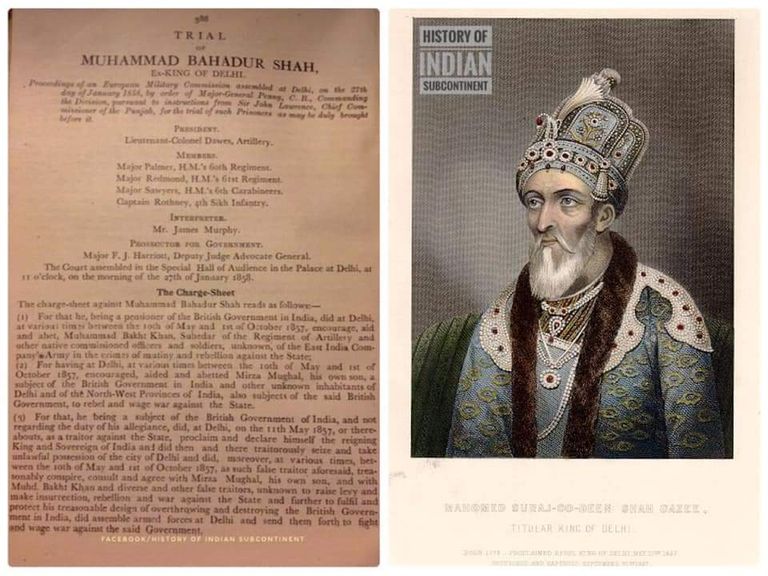
After the siege and later fall of Delhi a kangaroo court was established, to put on trial the most famous person of India, the king of Delhi, the last Mughal emperor. His crime was nothing apart from supporting a legitimate fight and resistance against an occupier, the most powerful empire of the time, ‘The British Empire’. His claim was legitimate; being the ruler of India he supported the Mutiny but denied any conspiracy against British Citizens of India. He accepted and treated every English man and woman of Delhi, as his own subject.
He was brought to this sham court and the East India Company tried to prove that, ‘He is the spiritual leader of resistance against the British all over the world’. Which he denied categorically. This was utilized as an old trick to make a case against a leader and a community. Especially if the leader of the revolt belonged to that community who was fighting all over the world against a super power. The nineteenth century was a messy century for the British. Empire who had one common enemy at different fronts and in different continents, it was Muslim and Islam. The Muslims of Sudan and Egypt (Africa), Muslim and Hindus of India, Ottoman in the Middle East and Muslims of Afghanistan and Central Asia. Like any other resistance in the history of mankind these resistance too required a spiritual support. All fighters against the Empire had a single spiritual inspiration to keep resistance going on and that was ISLAM.
Bahadur Shah Zafar had nothing to do with so called ‘an international conspiracy against the British Empire’; neither was he a leader of those resistances. An old Sufi King was unjustly punished for a crime he never committed, along with him mostly Muslims of Delhi suffered. They were routed out from Shahjahanabad. Below is an account from ‘The Last Mughal’
The court martial sat for the last time on 9 March, and at 11 a.m., in front of a croweded courtroom, Harriott made his closing speech. For two and a half hours, he again elaborated his theory of the Uprising being an international Islamic conspiracy. ‘I have endeavoured to point out’, he declaimed, ‘how intimately the prisoner, as the head of the Mahommedan faith in India, has been connected with the organization of that conspiracy, either as its leader or its unscrupulous accomplice….’
Harriott then added a concluding passage, criticizing the idea that the Uprising could be in any way connected with the activity of Christian missionaries, as some were already suggesting: ‘A candid undisguised eneavour to gain followers to Christ’, he said, ‘has never, that I am aware of, been viewed with the slightest sign of disapprobation by any portion of the natives….Christianity, when seen in it own pure light, has no terrors for natives….
Just before 3 pm, the judges retired to consider their verdict. A few minutes later, they returned to unanimously declare Zafar guilty ‘of all and every part of the charges preferred against him’.
The last Mughal pp 442-443
Below is an image of the chargesheet of Bahadur Shah Zafar